How To Have A Happy Marriage: 7 Powerful Secrets From Research
.
***
Before we commence with the festivities, I wanted to thank everyone for helping my first book become a Wall Street Journal bestseller. To check it out, click here.
***
Everybody wants to have a happy marriage. Unfortunately, on average, marriages get less happy with time.
You know this must be true because I have a chart: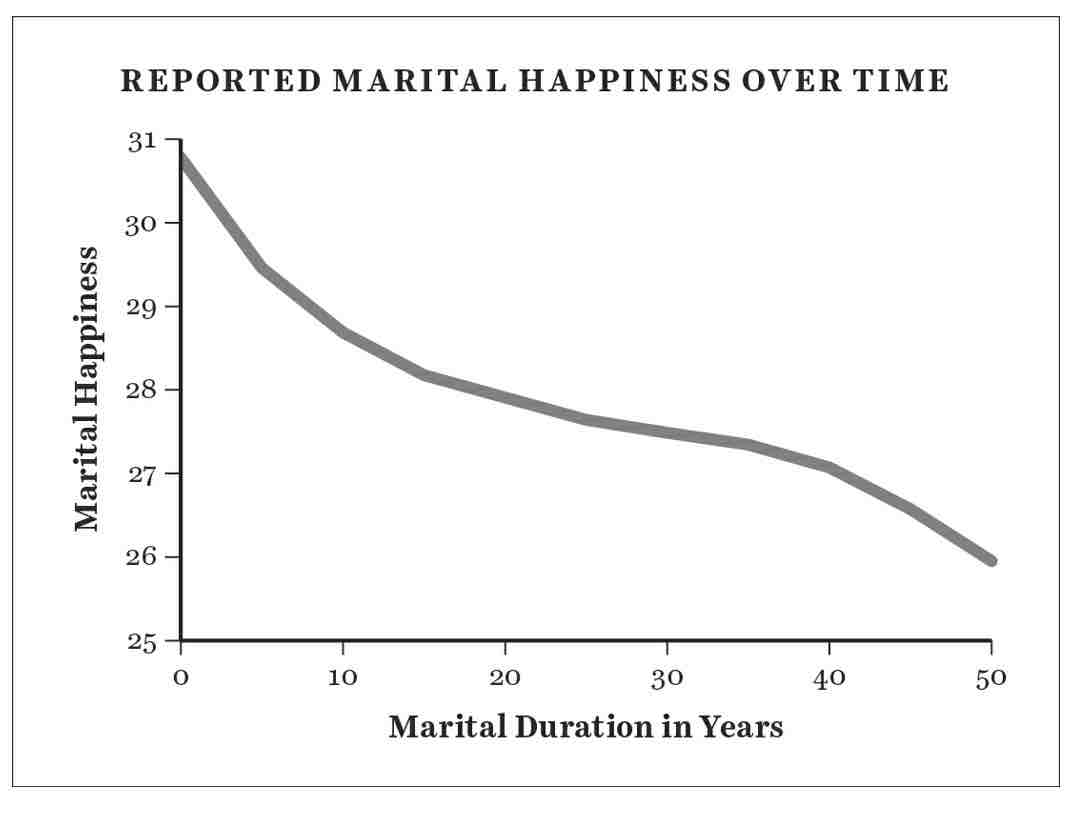 Actually, it’s worse than that because you have a lousy memory and your brain plays tricks on you. However happy you think your marriage is, it’s probably been less happy than that.
Actually, it’s worse than that because you have a lousy memory and your brain plays tricks on you. However happy you think your marriage is, it’s probably been less happy than that.
Researchers asked people how satisfied they were with their partnership. Then they checked in again later with the same subjects. A lot of people said things had gotten better. But they were wrong. People consistently misremembered how good things were the first time they were asked.
So here’s another depressing chart: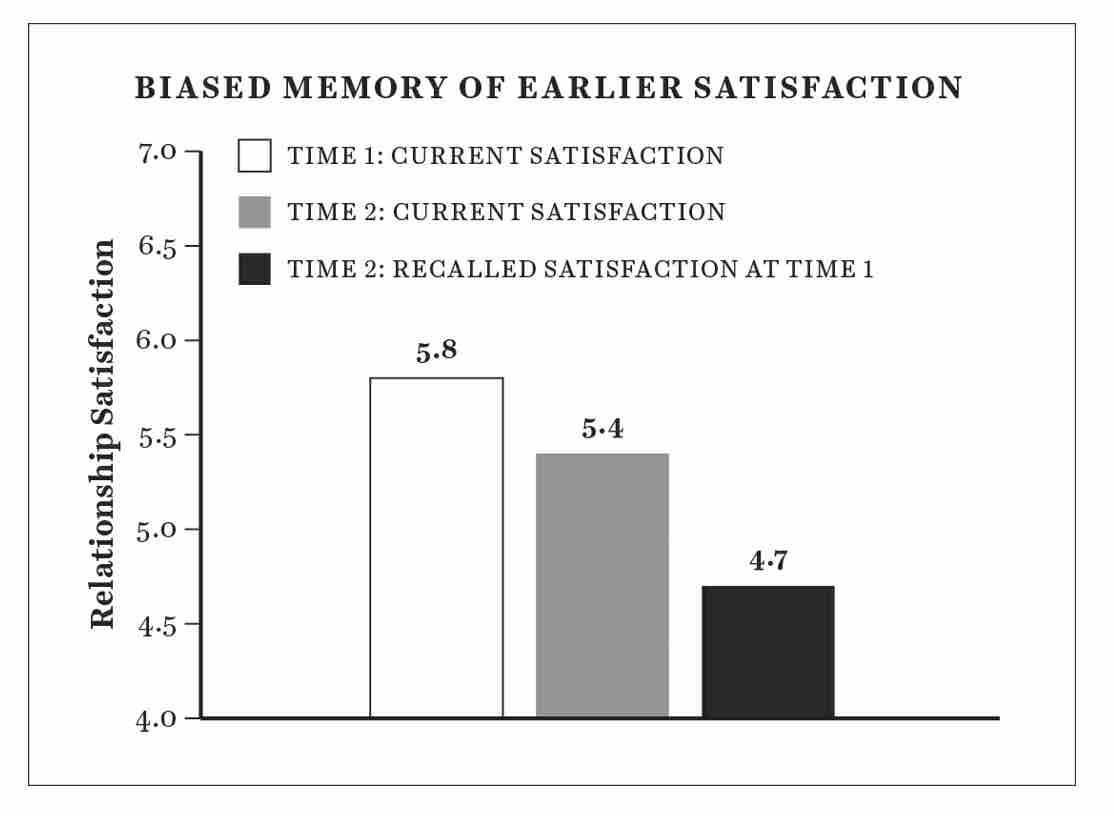 From The All-or-Nothing Marriage: How the Best Marriages Work:
From The All-or-Nothing Marriage: How the Best Marriages Work:
Even though people’s actual relationship satisfaction had declined from 5.8 to 5.4, their perceived relationship satisfaction had increased from 4.7 to 5.4. They achieved this self-delusion, which allowed them to believe the falsehood that they were becoming happier in the marriage, by misremembering their Time 1 satisfaction as being 4.7 when it was actually 5.8.
No, shouting at me won’t make this less true.
The “very happy” marriage has taken a seat next to pandas on the endangered species list.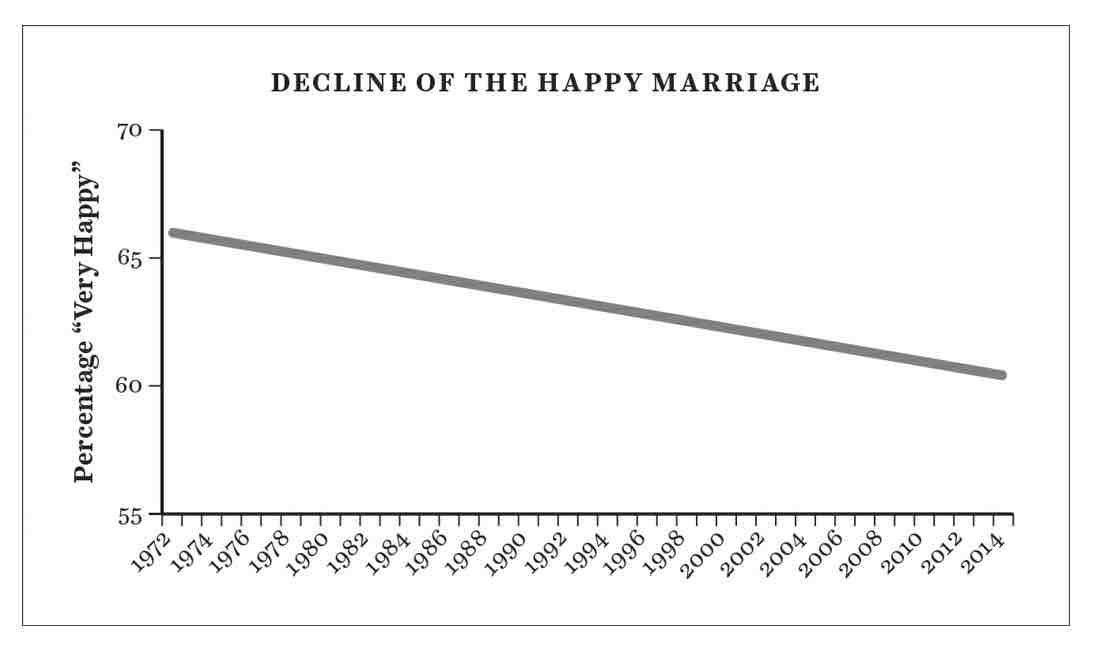 Before you start fumbling with the child-proof cap on the Prozac bottle, let me say there is a silver lining here. While the average marriage has gotten worse, the happiest marriages are better than they’ve ever been.
Before you start fumbling with the child-proof cap on the Prozac bottle, let me say there is a silver lining here. While the average marriage has gotten worse, the happiest marriages are better than they’ve ever been.
From The All-or-Nothing Marriage: How the Best Marriages Work:
Marriage, in short, has tilted toward an all-or-nothing state. As its primary functions have ascended Maslow’s hierarchy, and as we’ve spent less time with our spouse, it’s become more difficult for our marriage to live up to our expectations, which means that more of us wind up feeling disappointed. At the same time, as the nature of our marital expectations has changed, the benefits of fulfilling those expectations are larger than ever. Consequently, even as the average marriage is getting worse, the best marriages are getting better.
Alright, enough doom and gloom. How can we make our unions more like those super-duper happy ones?
We’re going to get some answers from Eli Finkel. (He does more than compile depressing charts, I swear.) He’s a professor of psychology at Northwestern University and the director of their Relationships and Motivation Lab. His book is The All-or-Nothing Marriage: How the Best Marriages Work.
Alright, let’s get started quick before those stats sink any lower…
Bad Things Are Exceptions, Good Things Are Traits
Everybody screws up. Your spouse is going to screw up. So how should you interpret those screw-ups? People with happy marriages see those mistakes as “external” (caused by context, not character) and “temporary” (as one-offs, not persistent traits).
So, repeat after me: your spouse was late picking you up because “traffic was bad today” and not because they “are and always have been an inconsiderate subhuman pig-man who will never ever change.”
From The All-or-Nothing Marriage: How the Best Marriages Work:
…the tendency to make internal and stable attributions for our spouse’s negative behaviors…predicts greater distress about those behaviors and greater deterioration in relationship quality over time. The tendency to make external and temporary attributions for such behaviors…does just the opposite, reducing distress about the behavior in question… If we’re confident that our partner is, by and large, a decent person who wants to do well by us, there’s a strong argument that we should seek to make attributions that give him or her the benefit of the doubt.
And you can turn this one inside out and double the benefits. When your partner does something good, you want to chalk that up to being “internal” (indicative of their character) and “stable” (a persistent trait).
They got you that thoughtful gift because they “are and always have been the kindest person to ever grace the earth with the imprint of their foot” and not because “every now and then even Satan remembers to do something nice.”
From The All-or-Nothing Marriage: How the Best Marriages Work:
Rather than separating our spouse from the behavior and treating it as a one-off event, relationships benefit when we link our spouse to the behavior and treat it as generally characteristic of him or her—when we make internal, stable attributions…the tendency to make internal and stable attributions for our spouse’s positive behaviors…predicts greater happiness about those behaviors and greater improvement in relationship quality over time.
The point here isn’t to begin a massive campaign of lying to yourself, but to give your partner the benefit of the doubt.
(To learn more about the science of a successful life, check out my bestselling book here.)
By interpreting issues the right way you can keep things positive and continue to see your soulmate as your soulmate.
Oh, by the way — you really shouldn’t see them as your soulmate. Ever…
“Meant To Be” Equals “Not Meant To Be”
I know, I know — this post is about as romantic as an episode of “Divorce Court.” But believing someone is your “soulmate” has a serious downside.
Psychologists call concepts like this “destiny beliefs” and they’re a pretty black and white way to see things. So when things get difficult, people who endorse ideas like “we were meant to be” tend to flip to “we weren’t meant to be.” Ouch. What’s a better perspective?
Much as with intelligence and learning, you want to have a “growth mindset” toward your relationship. Things aren’t set in stone, difficulties are normal, it’s going to take some work, but we can always improve.
From The All-or-Nothing Marriage: How the Best Marriages Work:
According to the psychologist Raymond Knee, people with strong destiny beliefs think that partners either are or are not “meant to be.” They view conflict and other relationship difficulties as indicators that they may simply be incompatible with their partner. People with strong growth beliefs, in contrast, think that partners can cultivate a high-quality relationship by working and growing together. They view conflict and other relationship difficulties as opportunities to develop a stronger relationship.
Stop talking about your marriage like it’s the fulfillment of an ancient prophecy and start endorsing ideas like, “A successful relationship evolves through hard work and resolution of incompatibilities” or “Challenges and obstacles in a relationship can make love even stronger.”
From The All-or-Nothing Marriage: How the Best Marriages Work:
One promising option for approaching our relationship in a growth mind-set is to take a few minutes every month to think about ways in which such statements are true, ideally focusing on instances in our own lives when, for example, overcoming an obstacle made a relationship stronger.
So see yourselves as a couple that has the skills to work through problems instead of the characters in some epic predestination story. As a general rule, your relationship should have as little in common with Oedipus Rex as possible.
(To learn the two-word morning ritual that will make you happy all day, click here.)
People give a lot of marital advice but one thing nobody ever tells us is “take things for granted.” You know why? Because 1) it’s a terrible idea and, 2) nobody needs to. Sadly, we’re excellent at doing it without a reminder…
Give Thanks
When even just one of you feels gratitude, both of you are more satisfied with the relationship. How’s that for a bargain?
From The All-or-Nothing Marriage: How the Best Marriages Work:
Algoe argues that gratitude serves as a “booster shot” for romantic relationships. People tend to experience higher gratitude on days when their partner does something thoughtful for them, and such gratitude predicts elevated relationship quality the next day. In fact, when one partner experiences elevated gratitude on a given day, both partners experience positive relationship outcomes. In the long run, people who experience elevated levels of gratitude also experience stronger relationship commitment and are less likely to break up.
Research shows that merely dedicating a little time to thinking about how your partner has invested in the relationship increases positive feelings toward them and elevates commitment to the marriage. And this often leads to a virtuous cycle.
From The All-or-Nothing Marriage: How the Best Marriages Work:
All of us can find a few minutes per week—before going to bed or while showering, perhaps—to think about ways in which our spouse has invested in our marriage. Doing so has the potential not only to bolster our gratitude and relationship commitment, but also to increase our overall happiness. And here’s the kicker: Because our own experience of gratitude tends to predict our partner’s warm treatment toward us, our decision to pursue a gratitude-increasing lovehack can increase our partner’s positivity toward us, potentially launching a virtuous cycle of mutual gratitude, kindness, and commitment.
Big benefits and you didn’t even have to express gratitude to your partner. Not that it would hurt, mind you. *blogger clears throat*
(To learn 5 secrets from neuroscience that will increase your attention span, click here.)
So it’s good to be thankful for the positive things they’ve done in the past. But what can you do for the positive things in the moment in order to make them that much better?
Capitalization
No, I don’t mean “use the big letters.” When discussing relationships everybody focuses on getting through the hard times. Turns out we have it backwards. Studies show that how you celebrate the good times actually has a much bigger effect on how happy your marriage is.
Capitalization is delighting in your partner’s good news. Being supportive, curious and enthusiastic when they get that big promotion, that big raise, or when the judge says “acquitted.”
From The All-or-Nothing Marriage: How the Best Marriages Work:
…the psychologists Shelly Gable and Harry Reis observe that social support is about much more than helping each other through hard times. These scholars have built a program of research demonstrating the power of delighting in good news together. In particular, communicating with our partner about personal positive events—that is, engaging in capitalization attempts—is linked to positive emotions and mental health, beyond any effect of the events themselves. Such capitalization attempts are also linked to greater feelings of trust, intimacy, and satisfaction in the relationship.
Every night each of you should share the best thing that happened to you that day. Listen intently, ask questions, and be enthusiastic. That’s all you have to do. Yes, really.
From The All-or-Nothing Marriage: How the Best Marriages Work:
…every evening over the subsequent week, the partners took turns discussing their most important personal positive event that day. Couples who had been trained in enthusiastic, celebratory responding—trained to ask questions about the event, show positive emotion about it, and generally be engaged and constructive during the interaction—tended to experience greater love for each other following those nightly discussions.
(To learn the secret to never being frustrated again, click here.)
But sharing good news is just the start. What’s the secret to better communication in a marriage?
Communication Is Key
Talking about relationships is good for your relationship. You don’t even have to talk about your relationship, necessarily. In fact, just watch “Casablanca” together and discuss it. Seriously.
Researchers had couples watch movies about relationships and then talk about them. Guess what? Those people were less likely to divorce.
From The All-or-Nothing Marriage: How the Best Marriages Work:
…each week over the next month, they viewed a different relationship-themed movie and discussed the same set of questions. Relative to participants in the no-treatment condition, participants in the intervention condition were about half as likely to separate or divorce over the next three years (13 versus 24 percent).
And try some self-disclosure. Open up. It’s tightly linked with higher relationship quality. And you don’t need to go full-therapy-session. Want to increase the passion in your relationship?
All it takes is a double date and opening up about yourself. When study subjects played a game involving self-disclosure while with another couple, romance was rekindled.
From The All-or-Nothing Marriage: How the Best Marriages Work:
When it came to feelings of satisfaction in the relationship, the self-disclosure task was beneficial regardless of whether the couple was on a double date or by themselves. But when it came to feelings of romantic passion, the self-disclosure task was especially beneficial in the double-date condition. In short, socializing with our spouse and other people can stoke the romantic fire in our marriage, but only if the socializing is fun and intimate.
(To learn 3 secrets from neuroscience that will help you quit bad habits without willpower, click here.)
And going on double dates isn’t the only way socializing can improve your marriage…
See Other People
No, don’t have an affair. That would be bad. Very bad. But these days we expect spouses to be our everything emotionally. And that is insane. You still need friends. You still need family.
A ton of research shows we need a “diversified social portfolio.” And we need them to be specialized: the friend who calms you down when you’re anxious, the family member who cheers you up when you’re down, the pal who helps you chill out when you’re angry. Your spouse can’t be expected to be the best at every one of those situations.
So what happens when you have a team of emotional specialist friends in your life? You don’t just feel better personally — your marriage gets better.
From The All-or-Nothing Marriage: How the Best Marriages Work:
In this nine-month study, breadth and specialization also predicted a decreased likelihood of breakup. In addition…having a highly specialized social portfolio protected participants from the typical decline in relationship well-being over time.
Did you catch that last sentence? The effect is so powerful it actually prevents the decline in relationship well-being that we saw in those scary charts up above.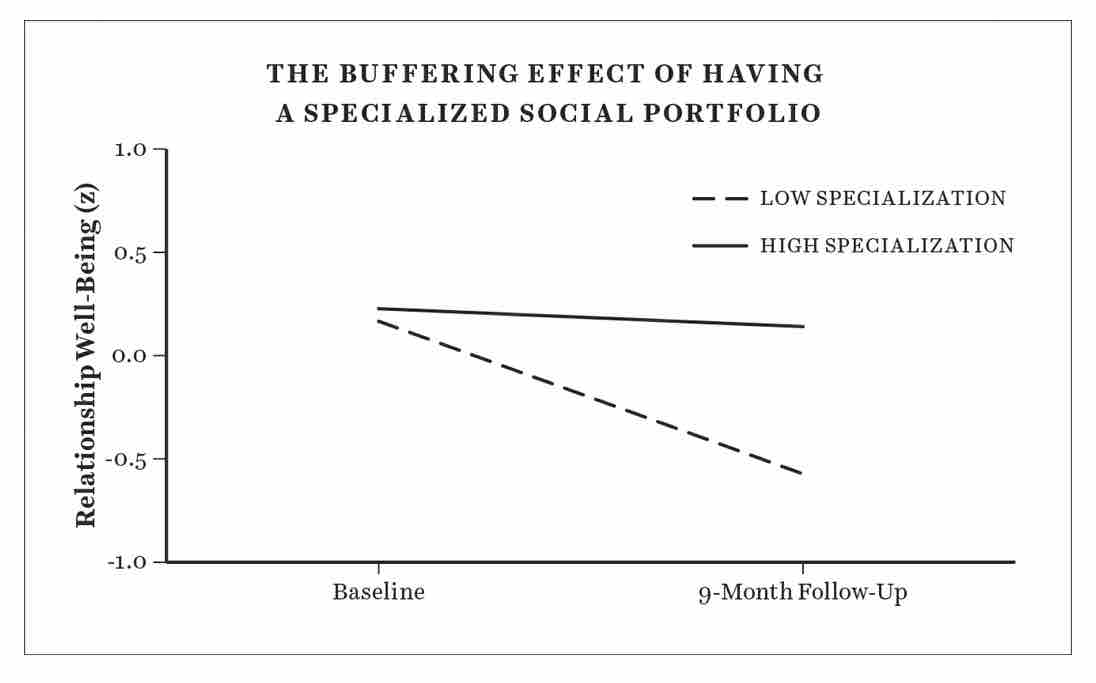 It also has the lovely benefit of not turning your spouse into a widow or widower.
It also has the lovely benefit of not turning your spouse into a widow or widower.
From The All-or-Nothing Marriage: How the Best Marriages Work:
A meta-analysis by the psychologist Julianne Holt-Lunstad reveals that people with high scores on broad measures of social integration—marital status, social network size, and social network participation—are about half as likely to die in a given follow-up interval (say, ten years) as people with low scores. This effect is larger than the effects of well-known predictors of mortality like smoking and obesity.
(To see the schedule that very successful people follow every day, click here.)
So you’ve got good friends and you’re not expecting your spouse to solve every problem you face. Cool. But when you two are together, what should you do?
Try A New Restaurant After You Go Skydiving
When you first start dating you do all kinds of cool stuff. Then you fall into a rut and your life together feels as scripted as a bad sitcom.
You’re not bored — you’re boring. So stop being boring. Keep doing new and exciting things together and the relationship can stay fun.
We all want to learn and grow and be stimulated — psychologists call it “self-expansion theory.” When you continue to do those types of things, relationship satisfaction goes way up. Oh, and something else happens too…
A lot more sex.
From The All-or-Nothing Marriage: How the Best Marriages Work:
In a study from the psychologist Amy Muise, relationship partners completed questionnaires about their relationship for twenty-one consecutive days. They reported how much self-expansion they experienced each day by completing items like: “How much did being with your partner result in you having new experiences?” and “How much did being with your partner expand your sense of the kind of person you are?” They listed activities like shucking oysters for the first time, taking ballroom dancing lessons, and taking a road trip. When participants reported greater self-expansion on a given day, both they and their partner reported experiencing greater sexual desire in—and greater satisfaction with—the relationship. They were also 36 percent more likely to have sex that day.
No, you don’t actually have to go skydiving. But your activities do need to be truly novel and exciting. “Pleasant” doesn’t cut it, bubba.
From The All-or-Nothing Marriage: How the Best Marriages Work:
A study by the psychologist Charlotte Reissman included a more stringent control condition. All couples made a list of activities that they view as exciting and a separate list of activities that they view as pleasant. They were then assigned to engage in either an exciting or a pleasant activity for ninety minutes for each of ten consecutive weeks. Relative to couples in the pleasant condition, couples in the exciting condition were happier in their relationship at the study’s conclusion.
(To learn the 4 secrets to reading body language like an expert, click here.)
Okay, we’ve learned a lot about how to defy those depressing marriage stats. Let’s round it all up and find out the very important — and incredibly simple — last thing you need to do…
Sum Up
This is how to have a happy marriage:
- Bad things are exceptions, good things are traits: When they don’t do the dishes it’s because they were busy. When they do do the dishes it’s because they’re a good person who loves you.
- “Meant to be” equals “not meant to be”: A growth mindset prevents your soulmate from becoming not-your-soulmate.
- Give thanks: Regularly think about all the nice things they’ve done to contribute to the relationship. (And maybe even thank them.)
- Capitalization: Be enthusiastic and make their little good things into big good things.
- Communication is key: Self-disclosure is powerful — especially on a double date.
- See other people: Supportive friends don’t take you away from your relationship; they improve it.
- Try a new restaurant after you go skydiving: Novel and exciting experiences together makes for happier marriages and increased sexy-time.
So what else do you need to do? I feel silly even saying it: spend more time together as a couple. Because these days, most people don’t.
From The All-or-Nothing Marriage: How the Best Marriages Work:
According to one major study, the amount of time that childless Americans spent alone with their spouse declined from thirty-five to twenty-six hours per week from 1975 to 2003, with much of this decline resulting from an increase in hours spent at work. The decline for Americans with children at home was from thirteen to nine hours per week, with much of it resulting from an increase in time-intensive parenting.
We expect so much from marriage in the modern era — and it does have the potential to deliver on those big expectations. The happiest marriages today are the best they have ever been.
Just put in a little effort and you can defy the trends and have one of those “very happy” marriages where the charts look upside down: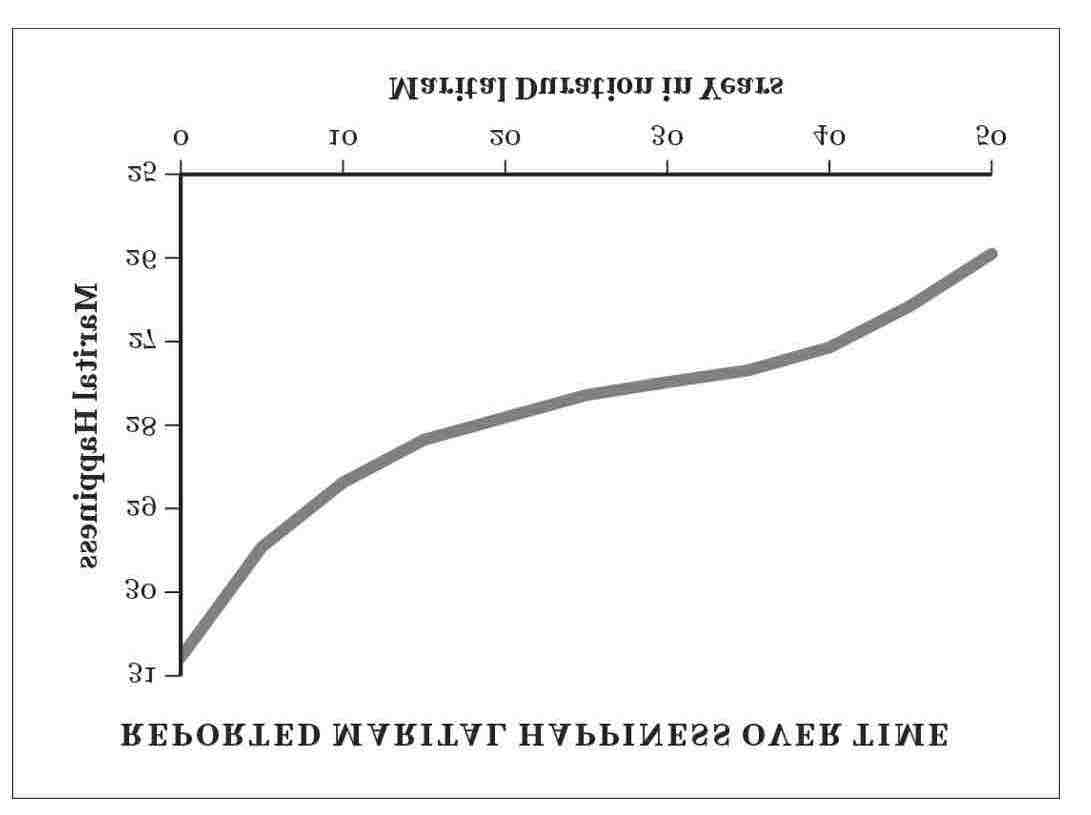 Join over 320,000 readers. Get a free weekly update via email here.
Join over 320,000 readers. Get a free weekly update via email here.
Related posts:
New Neuroscience Reveals 4 Rituals That Will Make You Happy
New Harvard Research Reveals A Fun Way To Be More Successful
How To Get People To Like You: 7 Ways From An FBI Behavior Expert




